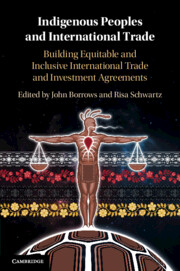 Indigenous Peoples and International Trade
Indigenous Peoples and International Trade from Part I - Indigenous Peoples and International Trade and Investment
Published online by Cambridge University Press: 11 June 2020
Chapter 4 looks at how Latin America has experienced both the negative effects of the international investment law system and tensions when trying to protect Indigenous peoples’ rights while simultaneously trying to attract foreign investment. Enrique Prieto-Ríos and Daniel Rivas-Ramírez present some prominent investment arbitration cases involving Latin American countries and the rights of Indigenous peoples. They conclude that Indigenous peoples in Latin America are invisible to investment arbitration tribunals because international investment arbitration is a self-contained system that does not look beyond international economic law to Indigenous rights or, more generally, human rights. Current negotiations among Canada, New Zealand and the Pacific Alliance offer an opportunity to consider including a chapter for Indigenous people. The addition of New Zealand and Canada as associate members means that they will have to address the rights of Indigenous peoples in some manner for domestic political reasons.
To save this book to your Kindle, first ensure [email protected] is added to your Approved Personal Document E-mail List under your Personal Document Settings on the Manage Your Content and Devices page of your Amazon account. Then enter the ‘name’ part of your Kindle email address below. Find out more about saving to your Kindle.
Note you can select to save to either the @free.kindle.com or @kindle.com variations. ‘@free.kindle.com’ emails are free but can only be saved to your device when it is connected to wi-fi. ‘@kindle.com’ emails can be delivered even when you are not connected to wi-fi, but note that service fees apply.
Find out more about the Kindle Personal Document Service.
To save content items to your account, please confirm that you agree to abide by our usage policies. If this is the first time you use this feature, you will be asked to authorise Cambridge Core to connect with your account. Find out more about saving content to Dropbox.
To save content items to your account, please confirm that you agree to abide by our usage policies. If this is the first time you use this feature, you will be asked to authorise Cambridge Core to connect with your account. Find out more about saving content to Google Drive.